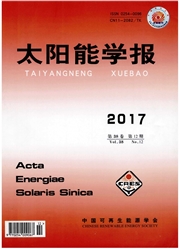

 中文摘要:
中文摘要:
采用粘性-无粘迭代程序XFOIL和CFD方法不同湍流模型预估了某改型风力机专用翼型的气动性能,通过和风洞实验结果的比较分析了不同计算方法线性区的预测精度和大攻角失速下的适用性,并研究了前缘粗糙度对翼型性能的影响。结果表明:在线性攻角下定常雷诺平均方程加合适湍流模型可精确预估翼型升力,SA模型升力结果略好于SST模型,XFOIL预估结果基本可信更适合初步设计时定性分析;大攻角失速下必须考虑流动分离的非定常特性,大涡模拟可以更好地反映流场发展过程;前缘粗糙度一定程度上降低了翼型气动性能,这种影响随翼型厚度的增加而加剧,改型翼型对前缘粗糙度敏感性不大,满足使用要求。
 英文摘要:
英文摘要:
The aerodynamic performance of an airfoil dedicated for large wind turbine was predicted by interactive viscousinviscid approach and computational fluid dynamics(CFD) method with different turbulence models. Wind tunnel test was conducted to validate predicted results and investigate leading edge roughness effect on airfoil performance. Results show that RANS with proper turbulence model can accurately predict airfoil lift within linear scope, and SA model delivers better lift than SST model, but XFOIL code exhibits only rough capability for analysis. At high angle of attack in stall region which characterized by large separation unsteadiness, LES may well reflect the flow development process. Leading edge roughness degrades airfoil performance, and this situation may become even worse on thick airfoils. The modified airfoil has a low sensitivity on leading edge roughness and fulfills the design demands.
 同期刊论文项目
同期刊论文项目
 同项目期刊论文
同项目期刊论文
 期刊信息
期刊信息
